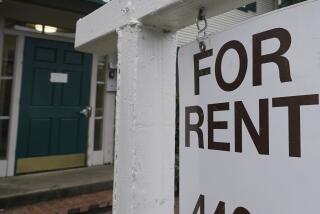Demystifying rental forms and language
- Share via
Whether you are a novice or experienced residential landlord, you will profit from reading “Leases and Rental Agreements” by Marcia Stewart and attorneys Ralph Warner and Janet Portman. It is filled with answers to frequently asked landlord questions, such as: “Is a lease or a month-to-month rental agreement better?”
In addition, the book contains fill-in-the-blank rental forms valid in any state, plus state addenda, such as Florida’s special rental disclosure form. Readers can photocopy the forms and use them as often as desired.
The book’s first 100 pages are devoted to explanations of key points in the rental agreements and other forms. The practical “Ten Tips for Being a Successful Landlord” provides short, no-nonsense explanations that get right to the point.
A special feature is the lead-based paint disclosure form and booklet that landlords of buildings constructed before 1978 must give to their tenants. The booklet, which can easily be photocopied, is also provided in Spanish.
Throughout the book are explanations of laws that apply to specific states. For example, just before the explanation of how to use the landlord/tenant move-in/move-out checklist is a list of the states that require this form. But it’s a smart idea to use it in every state.
Especially valuable are the clause-by-clause explanations of the lease and rental agreement forms.
These short sections highlight the importance of each clause so the landlord will understand the significance.
The book even includes the latest information on how many tenants to allow in a unit. This issue has subjected many landlords to discrimination allegations of setting low occupancy limits. The explanation details what landlords can and cannot do when setting limits on how many residents can occupy the premises.
On the topic of tenant security deposits, the book is especially detailed. There are specific clauses that landlords must add to the rental forms in nine states. Perhaps more important, the authors give practical advice about security deposits, such as not charging a non-refundable deposit for items such as carpet cleaning or pet damage.
The authors offer both legal and practical advice. Both are important for landlords, but the practical suggestions are invaluable, such as setting reasonable tenant rules and regulations. The authors show they understand the residential rental business.
More to Read
Sign up for Essential California
The most important California stories and recommendations in your inbox every morning.
You may occasionally receive promotional content from the Los Angeles Times.





